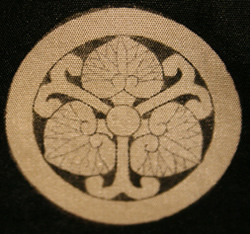 Summary of
Chinese Dynasties
Summary of
Chinese Dynasties Summary of
Chinese Dynasties
Summary of
Chinese DynastiesHsia Dynasty (c. 1994-1523 BC Semi-legendary) Emperor Yu
Shang Dynasty (1523-1027 BC) China's dress was based somewhere in the Shang Dynasty and used to differentiate status and between the high born and low born. The typical costume had two pieces, with narrow sleeves and coats long enough to reach the knees. The second piece was trousers, known as fu.
Chou (Zhou) Dynasty (c. 1027-256 BC): Classical age, Confucius and Lao-Tze, "Book of Rites of Zhou," great wall begun.
Ch'in (Qin) Dynasty (c. 221-206 BC): Unification of China under harsh rule of Shih Tuang-ti. Written language standardized. Great wall completed and connected.
Han Dynasty (c. 202 BC- 220 AD): Imperial age, with unification furthered but harshness lessened and Confucianism made basis for bureaucratic state. Buddhism introduced from India. Encyclopedic history, dictionary compiled, porcelain produced.
Three Kingdoms (220-265 AD): Division into three states, Wei, Shu and Wu, with Wei gradually dominant. Confucianism eclipsed. Increased importance of Taoism and Buddhism. Scientific advances in mathematics, medicine, astronomy and architecture from India
Tsin or Chin Dynasty (265-420 AD): Founded by a Wei general, gradual expansion to the southeast. Series of barbarian dynasties ruled N. China. Continued growth of Buddhism.
Sui Dynasty (581-618 AD): Re-unification, central government reestablished. Buddhism, Taoism favored. Great Wall re-fortified, canal system established.
T'ang Dynasty (618-907 AD): Territorial expansion. Buddhism temporarily suppressed. Civil Service examinations based on Confucianism. Age of great achievements in poetry, sculpture and painting. Most prosperous period of China's feudal society. People frequently traveled between countries, including Vietnam, India, the Eastern Roman Empire, Japan, Arabia, Korea and Persia. While the Chinese gained much in the way of ornament and cultural additions, they also greatly influenced other countries. The relation costume of Japan and Korea to Chinese costume is evident in this period.
Five Dynasties and Ten Kingdoms (907-960 AD): Period of warfare, official corruption, and general hardship. widespread development of printing; paper money first printed.
Sung Dynasty (Song) (960-1279 AD): Period of great social and intellectual change and an end to disunity. Rise of idealist philosophy when neo-Confucianism attains supremacy over Taoism and Buddhism. Central bureaucracy reestablished. Widespread cultivation of tea and cotton. Gunpowder first used in the military. It is in this period that women first began to bind their feet, but more about that later, when it became widespread.
Yüan Dynasty (1271-1368 AD): Mongol Dynasty founded by Kublai Khan. Growing contact with the west. Confucian ideals discouraged. Great age of Chinese play-writing. Revolts in Mongolia and south China end the dynasty. Visited and reported by Marco Polo
Ming Dynasty (1368-1644): Mongols expelled. Confucianism, civil service examinations reestablished. Contact with European traders, missionaries expanded. Porcelain (famous Ming vases), architecture, the novel and drama flourish. The Portuguese settled in Macao in 1557, but were not very successful due to anti-foreign sentiment.During the Ming Dynasty, dress underwent large-scale reform resulting in the restoration of regulations from previous eras, notably the Han.
Ch'ing (Xing) Dynasty or Manchu Dynasty (1644-1912): Established by the Manchus. Territorial expansion but gradual weakening of Chinese power. Increasing European trade, foreign powers divide China into spheres of influence, Opium war, Hong Kong ceded, Boxer uprising in 1900 was a last effort by Empress Tz'u Hsi to suppress foreign influence, last Chinese monarchy.
Last updated: 12/8/2020